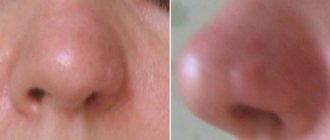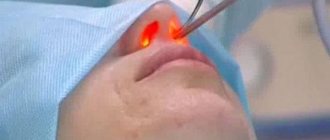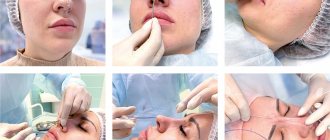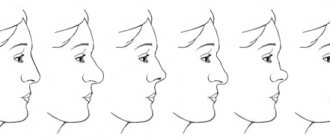- home
- Rhinoplasty
- Non-surgical rhinoplasty
Non-surgical rhinoplasty , or nose contouring, allows you to solve a number of aesthetic problems of the nose without resorting to traditional rhinoplasty. Non-surgical nose correction is becoming increasingly popular. And deservedly so. After all, this is an almost 100% guaranteed result, without the risk of anesthesia and surgery. With the help of non-surgical rhinoplasty, it is possible to correct the shape and size of the nose, instantly and permanently, and in some cases forever.
Indications for nose correction without surgery
Correction of asymmetry of the nasal bridge with injections of filler based on hyaluronic acid.
However, it should immediately be noted that the indications for nose correction without surgery are extremely narrow and must be strictly observed. The use of this technique is possible when the following problems exist:
- defects and deformations of the back and tip of the nose in the form of indentation, which can be easily corrected by non-surgical rhinoplasty;
- asymmetry of the back and/or tip of the nose, which, due to increased projection, can be corrected without surgery;
- insufficient projection of the tip of the nose;
- visible transition from the tip of the nose to the back.
- low bridge of the nose;
- Asian, African noses.
Non-surgical rhinoplasty can be used in a patient who has already had rhinoplasty as an alternative to revision rhinoplasty, when a minor correction is required, and the surgeon considers it inappropriate to perform a full-fledged operation, comparing the possible injury to the body from surgery and anesthesia with the existing defect. In this case, the surgeon can offer the patient contour plastic surgery of the nose, correcting existing defects with the help of a filler.
Non-surgical rhinoplasty can also be recommended to patients who are not sure about the need for surgery or are afraid of having it, or have not yet come to a clear understanding of how much they need rhinoplasty at all.
Advertising promises rhinoplasty without surgery: cheaper, safer! Hooray? You give injections of a special agent that softens the cartilage, wear a special pad, and the nose is deformed into a given shape. Great solution or cheese in the trap?
Plastic and maxillofacial surgeon Abramyan Solomon Maisovich talks about non-surgical rhinoplasty:
Is it possible to change the shape of the nose by injecting any substance?
I think the wording “non-surgical rhinoplasty” is incorrect.
Injections are nothing more than contour plastic surgery of small (up to 3-5 mm in diameter) defects in the nasal area. For example, you can fill a small dimple with hyaluronic acid filler and call it non-surgical rhinoplasty. Only HA-based fillers do not cause serious complications. I do not administer biopolymers or other solutions to my patients.
But the introduction of fillers is not an independent direction and cannot be a replacement for surgery.
What is “injection rhinoplasty”? Fillers based on hyaluronic acid are injected into the subcutaneous space of the nose. A nose that has been corrected in this way may swell every morning, as hyaluronic acid tends to accumulate fluid. The drug begins to dissolve after 3-6 months and in order to maintain a stable result, the procedure must be repeated 2 times a year. It's unstable and unpredictable.
Another issue is the use of HA-based fillers in the postoperative period. In this case, the drug behaves differently: it dissolves very slowly or does not dissolve at all - it is encapsulated, which allows you to maintain the required volume for a long time.
Is it possible to correct the bridge of the nose with fillers: to lift and straighten the bridge if there is a small hump?
Without surgery, it is impossible to affect the bone. The whole concept of “injection rhinoplasty” is work at the level of subcutaneous tissue, creating additional volume in the tissues.
To smooth out the “ethnic hump,” the doctor subcutaneously applies hyaluronic acid filler from the forehead to the base of the hump, thus lifting the skin. But at the same time, the frontonasal fold disappears, and in some cases the nose starts right from the eyebrows: it becomes cast, heavy, but without a hump. It does not look aesthetically pleasing, the shape is constantly changing, hyaluronic acid may begin to migrate (to the sides, down, to the base) or dissolve. A moderately stable result will last on average for 2-3 months.
As for the possibility of replenishing the missing volume in the area of the bridge of the nose when it is necessary to lift it - yes, this can also be done with the help of fillers. But, again, hyaluronic acid can move, and in the morning the nose will look swollen, taking on a neater appearance throughout the day.
Advertisements for “non-surgical rhinoplasty” promise “a reduction in the shape of the nose by reducing the volume of fatty tissue.”
This is quite a fashionable and common terminology. If an advertisement says “we have developed a drug and use it in our clinic,” this is most likely a lie. It takes on average 15-20 years to develop a truly new drug. Several thousand clinical trials are required for full testing. When they present a drug that has undergone serious clinical trials, then it will be possible to believe.
During “non-surgical rhinoplasty”, drugs are injected that have a local effect: lipolytics or glucocorticosteroid drugs – diprospan and kenalog.
Lipolitics.
To dispel all myths regarding this technique, it is necessary to remember the anatomy of the nose. Under the skin of the nose, the fatty tissue is very thin, about 1-1.5 mm. If you look closely at obese people, you will see that there is virtually no fat around the mouth, eyes, and nose area. Even if a person’s weight increases, this zone does not change: the body thus protects the senses, leaving them unchanged and maintaining the ability to live. Therefore, it is completely wrong to say that the size or shape of the nose can be changed due to fatty tissue. There is a tiny amount of fatty tissue in the nose.
The idea of non-surgical rhinoplasty was promoted to the masses by cosmetologists. Naturally, inexpensive and painless outpatient procedures that last about 30 minutes and do not involve bruising or swelling are very attractive. And classical rhinoplasty, at first glance, clearly loses. But there can be no talk of a stable result here! To interfere with the anatomy of the nose, it is necessary to understand due to which structures it changes. Therefore, the wording “due to the reduction of adipose tissue” only makes me smile. Then do liposuction of the nose, why inject anything.
Injections of Diprospan and Kenalog into the nose.
In large dosages, these drugs have a resolving effect, that is, they atrophy tissue. And the effect is not only on the subcutaneous tissue, but also on cartilage and skin. The bone does not atrophy, but the calcified structures are locally destroyed, and the bone becomes more fragile, “sugar-like.” Thus, the shape of the nose changes not only “due to subcutaneous fat,” but also due to the “dissolution” of cartilage and skin.
Nowadays, many patients turn to surgeons after such manipulations. And I have never seen an aesthetically acceptable result. Firstly, the drug is unpredictable; it affects each organism differently. Secondly, uncontrolled diffusion occurs - the chaotic spread of the drug into nearby tissues. Thirdly, one of the most unpleasant consequences of the administration of diprospan is skin atrophy. The skin becomes so thin that all blood vessels are visible and spider veins appear. It turns out that the skin literally lies on the bone, and it looks very ugly.
I am not against the use of Diprospan and Kenalog, but only in the postoperative period! I administer diprospan to patients after closed rhinoplasty to prevent scarring. But using it as a method of rhinoplasty is wrong; it is nothing more than misleading patients.
What are the possible negative consequences of administering diprospan for “non-surgical rhinoplasty”?
Example No. 1: the photo shows a patient after administering diprospan into the nose.
Subcutaneous fat tissue is practically absent. The drug also had an effect on the cartilage tissues and their resorption occurred. The nose has become sharp and angular, as cartilage is visible under the skin. It seems as if the skin is stretched over the bony skeleton.
A photograph cannot convey the full depth of the problem after such “non-surgical rhinoplasty”: the nose looks very unnatural, “toy-like”, as the volume is lost and the anatomy is disrupted. The skin also atrophied - it became transparent, like tissue paper. Any injury leads to the appearance of ulcers, perforation, and wounds do not heal for a long time. At the time the photographs were taken, 1.5 months had passed since the injection and the destructive effect of the drug was still ongoing - it would end only after 1.5-2 months.
Unfortunately, in such cases, the plastic surgeon is powerless: it is not known which bone structures remain intact and whether anything can be done. Even if the patient agrees to an unknown result, I do not operate on such patients. I undertake to operate on complex noses, even those that are practically absent. But I still don’t know how to help those who suffered from “non-surgical rhinoplasty” with diprospan.
Example No. 2: a patient after administration of a biopolymer in combination with hyaluronic acid.
The so-called biopolymer is silicone, there is nothing “biological” in it. The introduction of the biopolymer led to suppuration and a perforation appeared: a hole through which pus comes out. There is an inflammatory process, so the nose is very red.
Unfortunately, the previous doctor the patient visited tried to squeeze out the discharge. As a result, diffusion of the suppurating biopolymer occurred, which spread to almost all parts of the subcutaneous part of the nose. Severe inflammation in this case creates a risk of losing the tip of the nose.
Patients after “non-surgical rhinoplasty” come with a “valve effect”, various complications in the form of breathing problems, as well as a completely destroyed nasal structure. The bony base of the nose remains, but the subcutaneous cartilaginous part changes. Unfortunately, I can no longer help them. In the case of revision rhinoplasty, the results are quite predictable, but no one knows what we will get after “injection rhinoplasty”.
A rhinocorrector (a splint that compresses the nose), after wearing it for a long time, the shape of the nose supposedly changes.
If you delve deeper into history, people practiced artificial deformation of various parts of the body. These include deforming skulls, binding the feet of women belonging to high society in China, lengthening the neck with rings, and other examples.
The principle is clear: if from childhood you squeeze your nose with some kind of pad that will interfere with the process of its growth and formation, then yes, in theory it is possible to change the shape and size of the nose. But when the bone skeleton is already formed (usually this process ends at the age of 16-18, and, by the way, this is why plastic surgeons begin to perform rhinoplasty after this age), the bone will not change under the influence of external influences. Perhaps changes will occur in the skin and subcutaneous space.
The shape of cartilage cannot be changed. It can only be removed, pulled out, cut off, or the reinforcing structure broken. It is also impossible to change the shape of the bones. The structure of the nose is a very complex structure in which all tissues of the body are present: skin, subcutaneous fatty tissue, bone, cartilage, mucous membrane. And it is impossible to change the shape of this structure under the influence of some device.
And how long should a patient wear such a “rhinocorrector” in order to wait for the skin to atrophy? A year, two, three... On the contrary, today we, plastic surgeons, are directing all our efforts to making the correction and rehabilitation process as fast and comfortable as possible for the patient. We developed microrhinoplasty precisely with the goal of reducing recovery after surgery to a week, eliminating extensive hematomas, and minimizing tissue trauma. People go to a surgeon to get a predictable result with a shortened rehabilitation period, rather than walking around with a splint for an unlimited amount of time and waiting for a miracle.
Next advertisement: “We have developed a drug that significantly increases the elasticity of osteochondral tissue and reduces its volume.” After the injections, a plaster cast is applied for a day, and the hump disappears, the tip becomes thinner.
In this case, diprospan is used again, but in very large quantities.
Imagine the task of removing a hump without surgery. During a full-fledged rhinoplasty, the surgeon removes the hump and creates an open bridge of the nose. Next, the surgeon breaks the bones to bring the arches closer together to form a “pyramid.” If you solve this problem using a non-surgical method, using injections, then under the influence of diprospan, atrophy of the periosteum, subcutaneous fat, and skin will occur.
Bones lose calcium and become “elastic,” but that’s too fancy a name. In fact, they become fragile. The calcified structure of the bone does not allow it to become elastic; the bone cannot stretch. The hump may go away due to atrophy of the skin and tissue, but the bridge of the nose itself becomes square, wide, and a trapezoidal nose is obtained. Only surgery can achieve the desired result, but for this the bones need to be broken and brought together.
A plaster cast or post-operative nasal splint is not a shaping tool. First of all, they contain swelling and protect bone tissue from displacement. If the surgeon was unable to create the desired shape of the nose during the operation, it is extremely difficult to do this later with a splint or plaster. Moreover, it is impossible to do this without surgery.
To communicate with patients who have undergone rhinoplasty, come to our forum,
Rhinoplasty
In what cases is non-surgical rhinoplasty appropriate?
Non-surgical nose correction can be used both in the initial consultation of a patient who is not satisfied with the aesthetics of his nose, and for the correction of deformities after rhinoplasty has already been performed.
The most effective use of non-surgical rhinoplasty is for low nasal bridge. Excellent results are obtained when it is necessary to increase the projection of the nose, sharpen and lengthen its tip.
Non-surgical rhinoplasty photo: by resorting to non-surgical rhinoplasty, we were able to correct the obvious deformation of the patient’s nose, raise the bridge of the nose, and form a beautiful high profile of the bridge of the nose.
You can also achieve rotation (raising or lowering) of the tip of the nose, which is achieved by injecting filler into certain points. In addition, when performing non-surgical nose correction, not only fillers are used, but also botulinum toxin-containing drugs that allow you to influence the muscles of the nose and correct the direction of the trajectory of the tip of the nose. The method is also effective in correcting the nasolabial angle.
As we previously noted, a few years ago the main obstacle to the widespread development and use of contour rhinoplasty was the lack of fillers that would guarantee a stable result. Today, these fillers exist; moreover, they can be divided into temporary and permanent. At the same time, temporary fillers have a validity period from 6 months to 2 years. Permanent fillers include fat, but its use is extremely limited (there are practically no statistics on the use of fat during non-surgical rhinoplasty) and requires special knowledge, experience and indications from the surgeon.
Before and after photos: the patient came to the clinic in the hope that non-surgical rhinoplasty could solve the problems of his nose deformation. We managed to correct the consequences of an old fracture and straighten the bridge of the nose.
The most important thing that can be highlighted as a guarantee of achieving a good result is the experience of the surgeon performing non-surgical rhinoplasty, who must master traditional methods of surgical rhinoplasty, allowing him to feel and understand well both the internal structures of the nose and its external aesthetics and methods of correcting nasal deformities, as well as knowledge of the range of fillers on the market that are suitable for use in nasal contouring and the technique of their administration.
Thus, non-surgical rhinoplasty is a powerful, safe and guaranteed way to correct a number of nasal deformities, which depends on the experience and knowledge of the surgeon. This procedure is suitable for both very busy people and men who do not have time for long-term rehabilitation after traditional rhinoplasty. You see the results of nose contouring almost immediately, already the next day, when the swelling from the procedure goes away.
How to speed up healing
How much the nose swells after rhinoplasty is a very individual question. Recovery takes a different time for each patient. But it is still possible to help your body and stimulate speedy healing. To do this, you must follow the following rules:
- do not visit the bathhouse, sauna,
- do not take hot baths,
- do not tilt your head or body forward,
- limit physical activity,
- give up alcohol and cigarettes,
- sleep half-sitting.
High temperatures, as well as bending the body forward, promote blood flow to tissues, including injured ones, which negatively affects healing. In addition to avoiding thermal procedures, you can additionally help yourself by applying cold compresses to the operated area.
These recommendations and prohibitions do not apply for the rest of your life, but only for the first weeks after surgery. Following these rules will help speed up regeneration and reduce the number of days it takes for swelling to subside after rhinoplasty.
The operation is suitable for both women and men.
Prices for non-surgical rhinoplasty
The cost of non-surgical rhinoplasty depends on the volume and nature of the required correction. After making a diagnosis, the surgeon selects a filler, the price of which will ultimately largely affect the final cost of the procedure.
Non-surgical rhinoplasty price in Moscow
| Operation name | Cost in rubles |
| Nose correction using an injectable implant | 50000 |
See all prices
Diprospan injection after rhinoplasty
During the procedure, the specialist injects into the problem area of the nose using a thin needle. There may be some pain during the procedure. All this depends on the period after rhinoplasty. The shorter the period, the less sensitivity. In the early stages, sensitivity has not yet been restored and you may feel some numbness in the nose, and therefore, the pain is much less than at a time closer to a year after the operation.
After the injection, your nose may become swollen. The swelling usually goes away within a day. The drug has a long-lasting effect and is present in the treated area for several months. The positive effect of the drug begins 3-5 days after the injection. Diprospan acts only on soft tissue in the injection area and has no effect on the body.
General recommendations after a diprospan injection:
- do not apply decorative cosmetics to the area of application of diprospan for a day;
- on the same day it is forbidden to be exposed to UV rays;
- do not get hypothermic, if the injection occurred in winter, it is better to cover your nose after the injection outside with a scarf;
- saunas, steam baths, hot baths are naturally prohibited for a day;
- Avoid sports and increased physical activity for at least a day after the injection;
- do not rub the injection area.
The number of injections is individual in each case and is prescribed by the doctor. You should not ignore the surgeon’s recommendations for prescribing a diprospan injection. The injection can help resolve complications that arise in the early stages.
© PlasticRussia, 2022. All rights reserved. Full or partial copying of site materials without the consent of the portal administration is prohibited.
0
What else would you like to know?
How long swelling lasts after rhinoplasty is an individual indicator. It is most often impossible to determine exact terms, only averages. Even if the decline in swelling is a little delayed and does not correspond to what the surgeon said, this is normal and there is no need to worry. Remember that recovery depends on many factors (age, complexity of the operation, skin density and much more).
But if pronounced swelling lasts for a very long time, and is also accompanied by problems such as tissue compaction, pain, nasal discharge (purulent or bloody), increased body temperature, and the like, this is a sufficient reason to immediately contact your specialist and talk about these symptoms. Rhinoplasty is a complex operation, and although the skill of the surgeon and a good clinic help reduce the risks of complications to a minimum, such consequences cannot be excluded at all. Therefore, in case of the slightest doubt, it is advisable to consult your operating surgeon.









